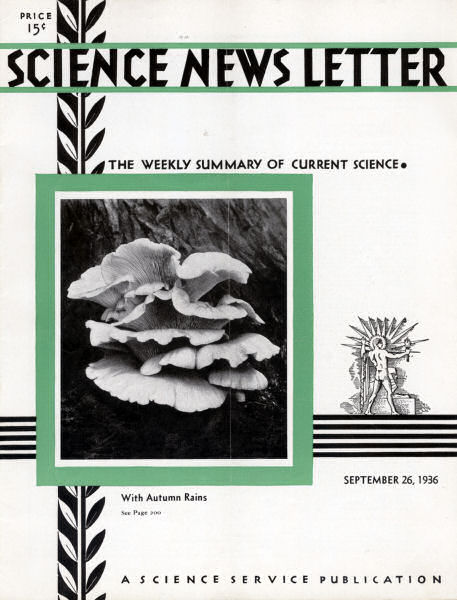From the September 26, 1936, issue

FALL SHOWERS BRING FORTH SEPTEMBER MUSHROOMS
As April showers bring forth May flowers, so autumn showers bring forth September mushrooms. In damp fields and moist, leaf-carpeted woods, their sudden, elfin appearance causes surprise and mystification, except to those who know that down out of sight the white, webby threads of mycelium have been growing slowly for months, sometimes for years, and that the now fast-expanding fruiting bodies were ready in the “button” stage long ago.
Among the most interesting, yet most common, of autumnal mushrooms is the elm fungus, Pleurotus ulmarius, that puts forth its really graceful clusters of thickish, creamy-white fans, ribbed underneath, from dead logs and stumps of the elm, and sometimes from branches of the living trees. This mushroom can be eaten freely without fear of ill consequences. It is well-flavored.
The photograph on the front cover of this week’s Science News Letter is by Cornelia Clarke.
“COLDEST” STAR IN UNIVERSE FOUND BY CHICAGO ASTRONOMER
What is probably the “coldest” star yet discovered by astronomers has been found by Dr. Charles Hetzler of Yerkes Observatory of the University of Chicago, it was announced by Dr. Otto Struve, director of the observatory.
The phrase “red hot” to most folks means high temperature, but in stars redness is associated with relative coolness, pointed out Dr. Struve. The stars discovered by Dr. Hetzler are redder than any previously known, and cannot be photographed in ordinary blue light.
While most stars have temperatures between 3,000 and 30,000 degrees, with a few “hot” ones at 50,000 degrees Centigrade, the new Hetzler stars have temperatures estimated at 1,000 degrees and below.
Use of special new infrared-sensitive photographic plates made possible the discovery. Five-hour exposures on the 24-inch Yerkes reflecting telescope were necessary to obtain the newest astronomical finding.
The discovery of very faint stars closer to the Earth and sun than any now known was predicted, following Dr. Hetzler’s report.
At present, the known star closest to the Earth is Centauri Proxima, whose light takes four-and-one-third years to reach the Earth. An immediate search for small, faint stars that may be closer is planned by Dr. Hetzler.
The new “heat-seeing” photographs are also expected to result in the discovery of more comets and asteroids, the small fry of the solar system which escape the astronomers’ eyes and ordinary photographic observation.
TRICHINOSIS 10 TIMES AS COMMON AS HAS BEEN SUPPOSED
Trichinosis, a painful and sometimes fatal disease contracted through the eating of infected pork, is fully 10 times as common as has hitherto been supposed. Not 2 percent, but 20 percent, of population samples studied had suffered from the malady at some time in the past.
This rather startling state of affairs in the nation’s public health was revealed by Drs. Donald L. Augustine and W.W. Spink, of Harvard Medical School, at a symposium on infectious diseases, part of the celebration of Harvard University’s third century of life. The figures are based on recent dependable studies of autopsy material in Boston, Minneapolis, and Rochester, N.Y.
Recent studies in his own laboratory have convinced Dr. Augustine that the commonly used diagnostic methods, of looking for the parasitic larvae in blood, spinal fluid, and body wastes are a waste of time, and that microscopic examination of bits of the patient’s muscle is of doubtful value. Far better, he declared, is a serological test that he has devised, using the parasites themselves to prepare an antigen. This method is specific for this one disease, except the skin tests when used in patients hypersensitive to other proteins.






